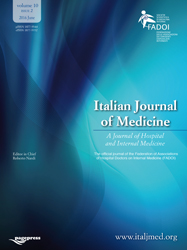Internal-surgical co-management in emergency surgery: proposal of an organizational model
All claims expressed in this article are solely those of the authors and do not necessarily represent those of their affiliated organizations, or those of the publisher, the editors and the reviewers. Any product that may be evaluated in this article or claim that may be made by its manufacturer is not guaranteed or endorsed by the publisher.
Authors
The perioperative care of patients undergoing emergency or urgent surgery often involves complex management, especially in elderly individuals with multiple comorbidities. Traditional consultative models, which rely on specialist referrals, may lead to fragmented care. To address this, an integrated model of medical-surgical co-management has been implemented at Careggi University Hospital. This approach emphasizes the involvement of internists in the perioperative management of surgical patients, aiming to enhance continuity of care and improve clinical outcomes. A cohort study was conducted comparing two groups of patients admitted to the Emergency Surgery Department: one group managed under the traditional model (2016-2019) and one group managed under the integrated model with internist involvement (2021-2024). Key outcomes, including length of stay, transfers to intensive care, mortality, and specialist consultations, were compared between the two cohorts. Data were collected using ICD-9-CM codes, with adjustments made for patient characteristics and procedures. The cohort managed with internist co-management (n=3427) had a significantly lower mortality rate (2.19%) and fewer transfers to intensive care units (ICU) compared to the cohort managed by surgeons alone (n=3870; 2.94% mortality, 12.3% ICU transfers). The number of specialist consultations for pulmonology, cardiology, and nephrology was also significantly reduced in the co-management group. However, no significant difference was observed in the length of stay between the two groups. The integration of internists in the management of emergency surgical patients resulted in improved clinical outcomes, including reduced mortality and fewer transfers to high-intensity care settings. While the length of stay did not change significantly, the co-management model appears to offer substantial benefits in optimizing care and resource use. Further prospective studies are needed to confirm these findings and evaluate the economic impact of this organizational model.
How to Cite

This work is licensed under a Creative Commons Attribution-NonCommercial 4.0 International License.






